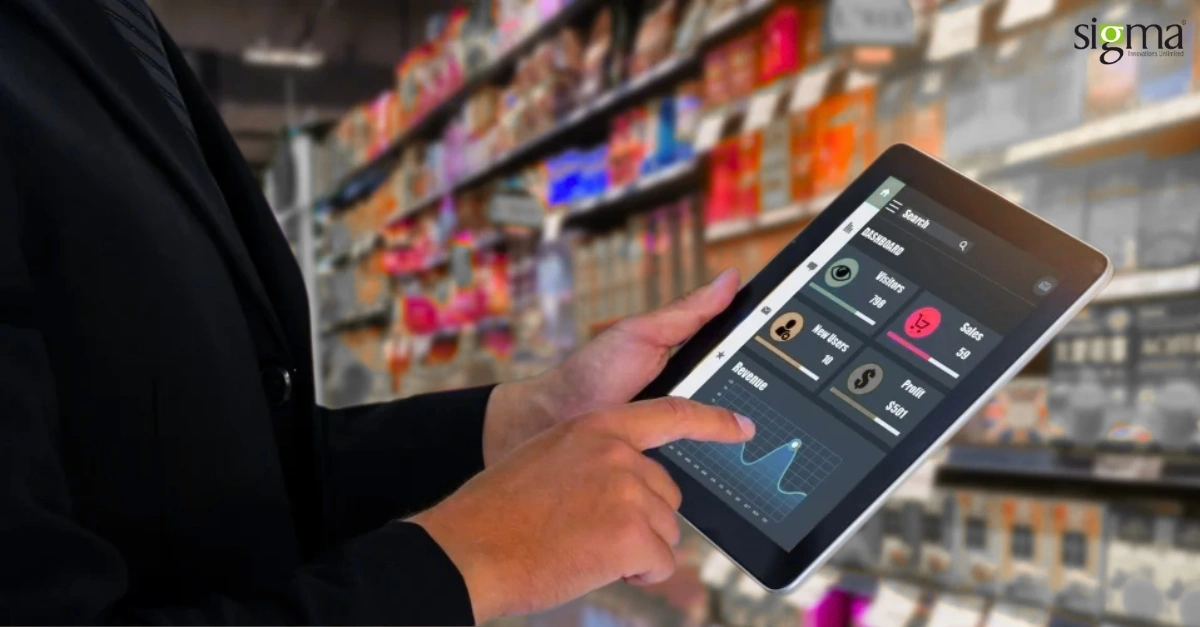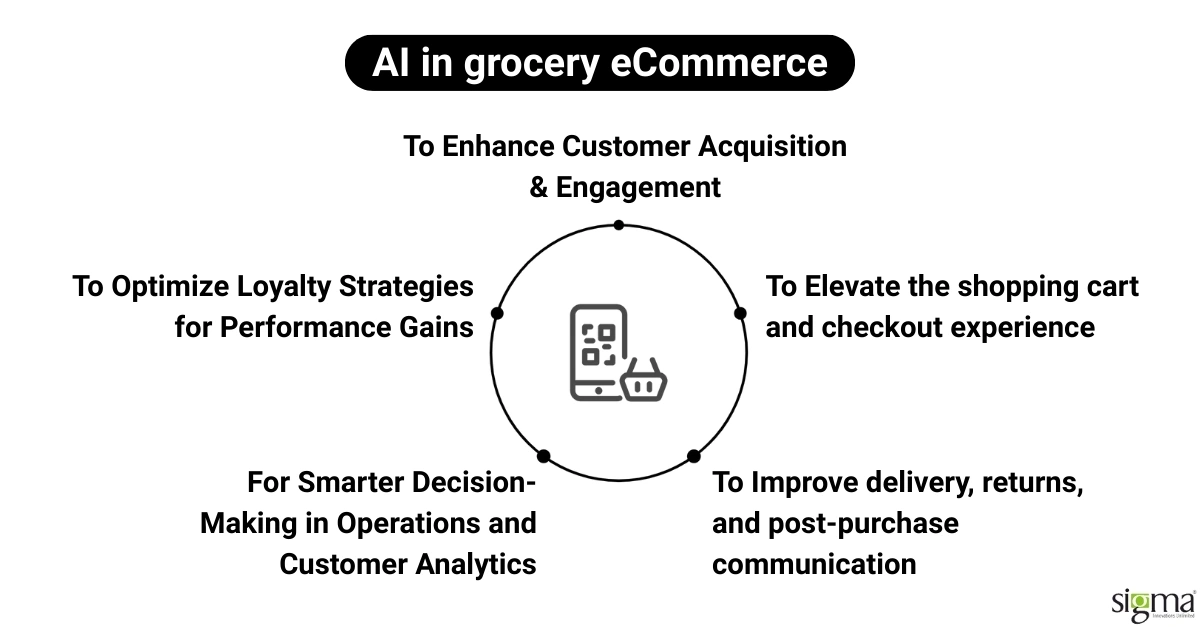The Ultimate AI Playbook for Grocery Retailers in 2025

The grocery eCommerce industry has undergone a rapid transformation in recent years, driven by shifting customer expectations, the rise of mobile shopping, and the need for operational efficiency. Artificial Intelligence (AI) is no longer a futuristic concept—it’s a critical driver of growth, efficiency, and customer satisfaction.
From personalizing product recommendations to optimizing delivery routes, AI empowers grocery retailers to deliver faster, smarter, and more engaging shopping experiences. In this blog, we consolidate and refine AI use cases that help drive growth and boost efficiency in the grocery industry eCommerce, highlighting common strategies and their business benefits. Whether you’re a small local grocer or a large online supermarket, these AI implementations can help you strengthen Customer Acquisition & Engagement, Smart Cart & Checkout, Seamless Fulfilment & Service, Intelligent Operations & Insights, and Continuous Feedback & Improvement.

1. Customer Acquisition & Engagement
Focuses on attracting and retaining customers through AI-driven personalization, discovery tools, and engagement strategies. Includes personalized content, dietary/allergen intelligence, voice & visual search, loyalty programs, and post-purchase engagement to foster long-term relationships.
| Use Cases | Description | Business Benefits |
|---|---|---|
| AI-Personalized Homepage Content & Promotions | AI segments users and adjusts homepage banners, content blocks, and product highlights in real time based on browsing history, location, and purchase behavior. | Revenue Increase: Higher engagement and conversion through relevant offers. Cost Decrease: Reduced promotional waste and bounce rates. Compliance: GDPR/CCPA/PDPL-compliant personalization. |
| AI Cross-Sell & Upsell Recommendations | AI identifies frequently bought together items and real-time upsell opportunities using cart content, purchase history, and user segments. | Revenue Increase: Raises AOV by surfacing relevant add-ons. Cost Decrease: Reduces manual merchandising effort. Compliance: Transparent pricing and no manipulative patterns. |
| AI Personalized Recipe, Meal Inspiration & Post-Purchase Content | Analyzes purchase history and dietary preferences to suggest recipes and complementary products post-purchase. | Revenue Increase: Encourages repeat purchases, boosts discovery. Cost Decrease: Reduces food waste and manual content curation. Compliance: Targets opted-in users and follows food claim regulations. |
| AI Dietary & Allergen Intelligence | AI scans product data to tag items based on dietary needs and allergens, allowing filtering and smart substitutions. | Revenue Increase: Builds loyalty among health-conscious shoppers. Cost Decrease: Reduces returns due to allergen issues. Compliance: Meets allergen labeling laws (FSAI/FDA/UAE). |
| AI Visual Search & Product Discovery | Enables customers to upload a photo or scan a barcode to find products or suggest related items. | Revenue Increase: Improves product discovery and conversion. Cost Decrease: Reduces product identification queries. Compliance: Consent-based image use with compliant labeling. |
| AI Conversational/Voice Search Assistant | Chat or voice-based AI assistant to handle natural language queries and cart building, supporting local terms and bilingual needs. | Revenue Increase: Converts high-intent queries faster, boosts engagement. Cost Decrease: Handles basic support queries. Compliance: Clear AI identity, opt-in voice input. |
| Personalized Loyalty Rewards & Engagement Content | AI tailors rewards, offers, and content (recipes, tips) based on user history and preferences. | Revenue Increase: Higher redemption and cross-sell rates. Cost Decrease: Reduced promotional waste. Compliance: Transparent data usage and opt-out options. |
Read the Blog to Know More About Staying Agile in eCommerce with Changing Customer Behavior.
2. Cart & Conversions
Optimizes the shopping cart and checkout experience with AI-powered recommendations, pricing strategies, fraud prevention, and checkout simplification to maximize conversion rates.
| Use Cases | Description | Business Benefits |
|---|---|---|
| Predictive Cart Completion & Forgotten Item Reminders | Prompts customers to add frequently purchased or likely missing items before checkout. | Revenue Increase: Higher AOV, recovered missed sales. Cost Decrease: Consolidated orders reduce delivery costs. Compliance: Transparent suggestions with customer consent. |
| AI Bundle & Promotion Optimization | Suggests dynamic product bundles or promotions based on cart contents and thresholds. | Revenue Increase: Boosts basket size via curated bundles. Cost Decrease: Moves slow inventory with top sellers. Compliance: VAT-inclusive and safe product bundling. |
| AI Dynamic Pricing & Promotion Optimization | Adjusts prices and offers based on basket contents, demand, and margin-aware logic. | Revenue Increase: Boosts conversion rates without over-discounting. Cost Decrease: Reduces waste of perishables via targeted offers. Compliance: Fair, transparent pricing logic. |
| AI Fraud Detection & Secure Checkout | Real-time fraud risk scoring with ID verification for restricted items. | Revenue Increase: Reduces chargebacks, builds trust. Cost Decrease: Lower manual verification costs. Compliance: Payment security & privacy law adherence. |
| AI Address Validation & Delivery Slot Optimization | Verifies addresses and suggests optimal delivery slots based on traffic and clustering. | Revenue Increase: More successful deliveries. Cost Decrease: Lower failed delivery rates. Compliance: Customer consent for location use. |
| Predictive Reorder & Subscription Suggestions | Suggests reorders or subscriptions for frequently purchased items. | Revenue Increase: Improves retention and LTV. Cost Decrease: Predictable demand improves planning. Compliance: Transparent, opt-in subscriptions. |
3. Fulfilment & Customer Operations
Improves delivery, returns, and post-purchase communication using AI for route optimization, proactive tracking, chatbots, and automated issue resolution.
| Use Cases | Description | Business Benefits |
|---|---|---|
| AI Route Optimization for Last-Mile Delivery & Slot Scheduling. | Groups orders and calculates optimal delivery routes and slots based on live data. | Revenue Increase: More capacity without extra resources. Cost Decrease: Lower fuel and labor costs. Compliance: Supports sustainability commitments. |
| Real-Time Delivery Tracking & Proactive Alerts/Communications. | Predicts accurate delivery ETAs and sends proactive updates. | Revenue Increase: Fewer missed deliveries, higher trust. Cost Decrease: Fewer “where is my order” queries. Compliance: GDPR/PDPL-compliant tracking. |
| 24/7 AI Chatbot for Customer Service | AI bot handles FAQs, order tracking, and product queries with multilingual support. | Revenue Increase: Resolves pre-sale doubts, enabling purchases. Cost Decrease: Lower support workload. Compliance: Identity verification before sharing data. |
| AI-Assisted Returns & Issue Resolution | Uses image recognition and NLP to verify and process returns quickly. | Revenue Increase: Higher loyalty through quick resolution. Cost Decrease: Reduced manual review effort. Compliance: Consumer rights law alignment. |
4. Intelligence & Decision-making
Equips backend teams with AI tools for smarter decision-making in inventory, supply chain, warehouse operations, and customer analytics.
| Use Case Title | Description | Business Benefits |
|---|---|---|
| AI Demand Forecasting & Dynamic Stock Optimization | Predicts product demand based on trends, events, and seasonality. | Revenue Increase: Prevents stockouts, captures trends early. Cost Decrease: Reduces waste and carrying costs. Compliance: Supports food safety and freshness norms. |
| AI Product Catalog Enrichment & Compliance Checking | Auto-tags products with attributes, ensures labeling compliance, and enriches descriptions. | Revenue Increase: Improves discoverability and SEO. Cost Decrease: Automates catalog maintenance. Compliance: Meets food labeling laws. |
| AI Supply Chain & Procurement Optimization | Analyzes supplier performance and trends to optimize sourcing. | Revenue Increase: Avoids stockouts, expands range. Cost Decrease: Finds cost-effective suppliers. Compliance: Ensures sourcing transparency. |
| AI Warehouse Picking & Packing Optimization | Optimizes pick routes, packing sequences, and workload distribution. | Revenue Increase: Faster, accurate fulfillment. Cost Decrease: Lower labor and error costs. Compliance: FIFO compliance and safe handling. |
| AI Customer Segmentation & Experience Optimization | Segments customers based on behavior to personalize marketing and UX. | Revenue Increase: Higher targeted campaign ROI. Cost Decrease: Reduced irrelevant marketing. Compliance: Behavioral segmentation without personal identifiers. |
| AI Sentiment Analysis on Customer Feedback | Analyzes feedback from multiple channels to identify trends and issues. | Revenue Increase: Improves retention via quick issue resolution. Cost Decrease: Less manual review of feedback. Compliance: Visibility into complaints for regulatory diligence. |
5. Feedback & Continuous Improvement
Uses AI to analyze feedback, test improvements, and optimize loyalty strategies for ongoing performance gains.
| Use Cases | Description | Business Benefits |
|---|---|---|
| AI-Powered Product Reviews Summary & Q&A | Summarizes verified reviews and answers common questions. | Revenue Increase: Reduces decision fatigue, boosts conversion. Cost Decrease: Fewer product-related queries. Compliance: Truthful, verified content only. |
| AI UX Optimization & Continuous A/B Testing | Tests and optimizes UI and promotional elements across user segments. | Revenue Increase: Better conversion through UX tuning. Cost Decrease: Less manual testing effort. Compliance: Ethical testing with anonymized data. |
| AI-Driven Loyalty & Feedback Loop | Links feedback insights to loyalty offers and retention campaigns. | Revenue Increase: Higher engagement through tailored rewards. Cost Decrease: Better targeting of retention spend. Compliance: Consent-based personalization. |
Our success story: Magento & Theme Upgrade for a Leading Irish Grocery Store. Read to know more.
Conclusion
AI is no longer optional for grocery eCommerce—it’s a necessity. The combined insights from different regions prove that personalization, predictive analytics, and automation drive real results in customer satisfaction, operational efficiency, and revenue growth. By strategically implementing these AI use cases, grocery retailers can stay ahead of the competition, respond faster to market changes, and deliver shopping experiences that keep customers coming back.
Whether you’re running your store on Adobe Commerce, Adobe Commerce Cloud, Shopify, Shopify Plus, WooCommerce, BigCommerce, or a headless commerce setup, AI offers the tools to transform every stage of the customer journey—from a smarter homepage to a proactive delivery tracker to intelligent stock forecasting. Now is the time to move from exploration to execution—because in grocery eCommerce, the future is already here.
